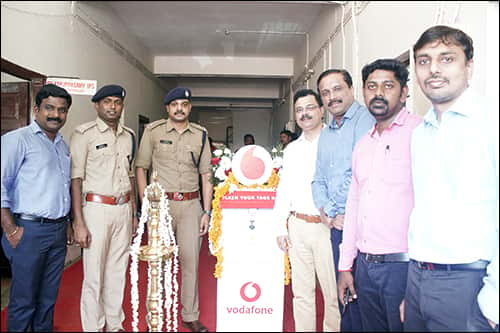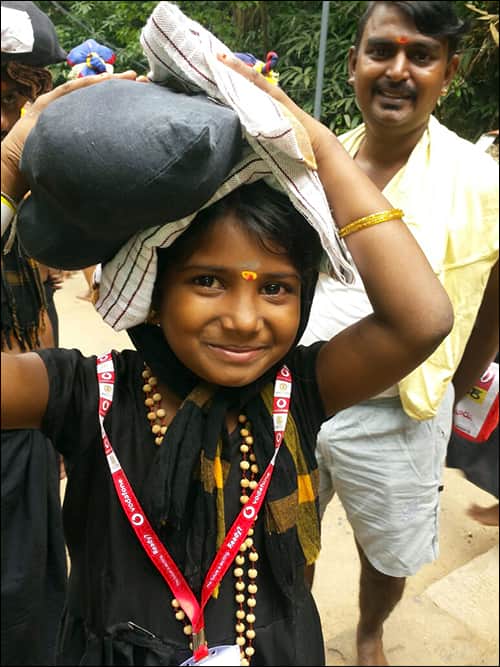Every year, millions of pilgrims visit Sabarimala as part of a holy Hindu pilgrimage, one of the largest attended events in the world. During the pilgrimage—a ritual trek of a mountainous trail to a temple, attended by between 40 and 50 million people—children can become separated from their parents or guardians. Such incidents can be traumatic for both the children and the adults with whom they are traveling, as well as time-consuming for police officers dedicated to keeping the pilgrims safe.
The Kerala State Police are using passive high-frequency (HF) RFID technology provided by Vodafone to help protect the children. The system enables the agency to keep an eye on kids under the age of 14 so that none of them end up missing during the annual Sabarimala yatra (the procession of pilgrims).

The pilgrimage, which dates back to the 12th century, takes place at the Periyar Tiger Reserve, located in India's Western Ghat mountain range. It requires some climbing by those who attend, both young and old. To reach the temple, worshippers must trek to the top of the hill at an altitude of 4,133 feet. The temple is open for worship only during the Mandala Pooja ritual, which is practiced throughout November and December. Since women between the ages of 10 and 50 are not permitted to participate, there is a lack of motherly supervision for the children who take part.
The path has become highly developed, offering emergency shops and medical aid for those who require assistance. In some cases, elderly or disabled pilgrims hire men to carry them to the top on a bamboo chair. The path is typically crowded as well. So within this environment, children can become separated from those watching over them.
During each year's yatra pilgrimage, the Kerala State Police respond to several hundred reports of lost children. The solution is intended to provide an automatic record of where each child is located. In the event that one or more is lost, the system enables police to help parents or guardians, while also freeing up time that officers would otherwise spend searching for missing kids. The RFID system for children is voluntary, and is provided to users free of charge.
Families traveling with kids this year first visited the Kerala State Police office in the city of Pamba. That station is located at the bottom of the 3-kilometer (1.9-mile) hill that the pilgrims climb to reach the Ayyapan Shrime at Sabarimala, according to Ajit Chaturvedi, Vodafone's Kerala business head.
Officers collected identification information for each child and his or her family members, including the names of both the child and the guardian, along with a contact phone number. That data was linked to the unique ID number encoded in a Vodafone 13.56 MHz HF RFID tag compliant with the ISO 15693 standard, which the child could then wear on a lanyard. Each tag uses an NXP Semiconductors MF chip.

"A handheld reader is used for data entry" by the officers, Chaturvedi explains, "and there are fixed readers along the pilgrimage path." Vodafone installed ten such fixed readers, manufactured for Vodafone according to the company's specifications, along the path traversed by all pilgrims. Each Vodafone reader comes with an HF reader IC and an antenna to capture the unique IDs of passing children's tags. The reader then forwards the collected data to a local server via a cellular GPRS network.
Six readers have been used thus far, Chaturvedi says, while the other four have yet to be commissioned. Each time a child wearing an RFID tag came within range of a fixed reader, his or her information was captured and forwarded to the Vodafone software, which identified that individual and sent a message to the guardian's phone indicating where the child was located.
Chaturvedi declines to indicate how many children used the tags this year, but says "the numbers are sufficient" to provide police with knowledge of where the majority of children are located. In the event that an unaccompanied child was found along the path or at the temple, officers escorted him or her to their onsite office and utilized a handheld reader to capture the unique ID number of that child's tag. The ID was then displayed in the software, and the officers could contact the child's guardian.
To date, the system has been working well, Chaturvedi reports, and installation was straightforward. "As of this initiative," he states, "no significant technical challenge was encountered during the installation and commissioning."



